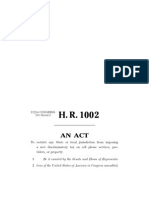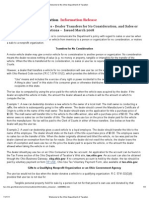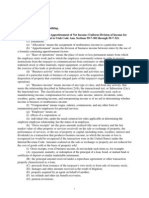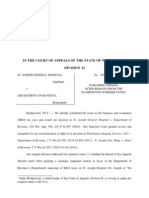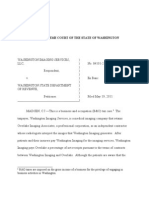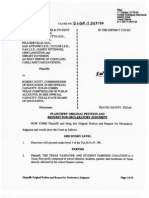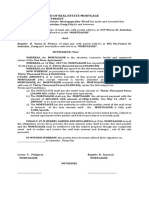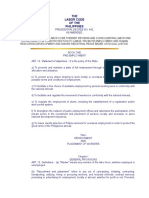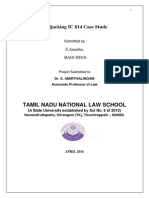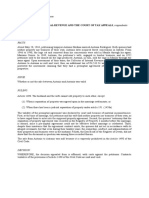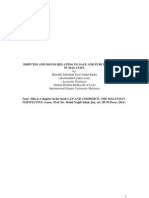Professional Documents
Culture Documents
In Re Broadview Networks, Inc. (NY)
Uploaded by
Paul MastersOriginal Description:
Original Title
Copyright
Available Formats
Share this document
Did you find this document useful?
Is this content inappropriate?
Report this DocumentCopyright:
Available Formats
In Re Broadview Networks, Inc. (NY)
Uploaded by
Paul MastersCopyright:
Available Formats
STATE OF NEW YORK DIVISION OF TAX APPEALS ___________________________________________ In the Matter of the Petition of BROADVIEW NETWORKS, INC.
: : : DETERMINATION DTA NO. 822673
for Revision of a Determination or for Refund of : Sales and Use Taxes under Articles 28 and 29 of the Tax Law for the Period December 1, 2001 : through August 31, 2004. ___________________________________________ : Petitioner, Broadview Networks, Inc., filed a petition for revision of a determination or for refund of sales and use taxes under Articles 28 and 29 of the Tax Law for the period December 1, 2001 through August 31, 2004. A hearing was held before Dennis M. Galliher, Administrative Law Judge, at the offices of the Division of Tax Appeals, 500 Federal Street, Troy, New York on June 22, 2010 at 10:30 A.M., with all briefs to be submitted by November 19, 2010, which date commenced the sixmonth period for issuance of this determination (Tax Law 2010[3]). By a letter dated April 20, 2011, this six-month period was extended for an additional three months (Tax Law 2010[3]). Petitioner appeared by Ryan, Inc. (Charles Rice, Jr., Esq., and Mark Weiss, Esq., of counsel). The Division of Taxation appeared by Mark F. Volk, Esq. (Robert A. Maslyn, Esq., of counsel).
-2
ISSUE
Whether petitioner has established entitlement to a refund of sales tax paid on its charges to its customers, to the extent such charges were later deemed uncollectible and were deducted as bad debts for federal income tax purposes. FINDINGS OF FACT 1. Petitioner, Broadview Networks, Inc. (Broadview), was formed in New York State in 1991, and operates as a network-based business communications provider primarily serving small and medium sized business customers throughout the Northeast and Mid-Atlantic states. Petitioner offers local and long distance voice communications, hosted and premises-based VoIP systems, data services, traditional telephone hardware, high-speed internet services, a full suite of managed services and a range of professional services. 2. Petitioners corporate headquarters are located in Rye Brook, New York. Petitioner maintains leased offices in various cities in New York, Pennsylvania, New Jersey, Rhode Island, Maryland and Massachusetts, and also maintains switches in New York, Pennsylvania, Massachusetts and Virginia. 3. Petitioner was registered as a New York State sales tax vendor and filed sales and use tax returns, remitting therewith for the period at issue sales and use taxes in the amount of $16,220,661.00. The Division of Taxation (Division) audited petitioner for the period spanning December 1, 2001 through August 31, 2004, and as a result of that audit issued to petitioner a Notice of Determination dated August 6, 2007 assessing additional sales and use taxes due in the amount of $690,369.78 for the period of the audit, plus penalty and interest.1 The amount
1
Petitioner executed consent documents with respect to the period of limitation on assessment such that sales and use taxes for the period December 1, 2001 through August 31, 2004 could be assessed at any time on or before September 20, 2007.
-3
assessed was comprised of tax calculated as due on allegedly nontaxable or exempt sales ($581,701.48), recurring expense purchases ($64,554.32) and fixed asset purchases ($44,113.98). In support of its imposition of penalty, the Division noted that petitioner did not furnish source documents (e.g., sales invoices or sales journals) in support of the amount of sales it reported. Notwithstanding this lack of source documents, the Division ultimately accepted the amount of gross sales reported based upon the results of a prior audit of petitioner. 4. Petitioner challenged the assessment by requesting a conciliation conference with the Divisions Bureau of Conciliation and Mediation Services (BCMS). By a Conciliation Order dated September 5, 2008 (CMS No. 221404) the statutory notice was sustained in full. 5. Petitioner continued its challenge by filing a petition. Petitioner alleged in paragraphs 23 and 24 of its petition that documentation had been presented during the audit to support a claim for credit or refund of sales tax remitted by petitioner on New York customer accounts that became uncollectible (bad debts) and were written off by petitioner during the audit period. No such credit or refund has been allowed, and petitioner continues to assert its entitlement thereto. 6. The Divisions answer alleged, in response to paragraphs 23 and 24, that petitioner did not properly apply for or provide substantiation in support of such claimed (bad debt) credit or refund, and is not entitled to any such credit or refund. 7. By a motion for summary determination filed by the Division on July 24, 2009 and opposed by petitioner, the Division sought a determination that petitioner was time-barred from pursuing the portion of its petition that requested a sales tax refund or credit based on uncollectible (bad debt) amounts. The Divisions motion was denied by an order dated January 7, 2010, concluding that petitioner had raised and preserved its claim for credit or refund, and
-4
ordering a hearing on the issue of the sufficiency of petitioners proof in substantiation of its claim for credit or refund. 8. At hearing, the parties stipulated that the amount of tax due as the result of the audit is $145,341.26, and that the amount determined and assessed by the Notice of Determination ($690,369.78) is to be reduced to that amount. The parties further stipulated that in light of the consents executed to extend the period of limitations on assessment (see footnote 1), the period within which petitioner could file a claim for refund or credit based on uncollectible amounts was likewise extended to March 20, 2008. 9. On or about September 15, 2005, during the course of the audit, petitioners initial representative advised the auditor that petitioner sought credit for sales tax paid on bad debts (i.e., sales tax paid [advanced] by petitioner based on sales it made that allegedly later became uncollectible). While petitioners representative apparently provided some computer printouts with customer names and amounts (presumably representing such uncollectible sales), no dollar amount of refund or credit sought was specified. Further, according to the auditor, the amounts set out in the computer printouts were not summarized and included customers whose addresses were not New York addresses. In addition, the auditor could not reconcile petitioners sales information (absent source documents) with petitioners accounting records and sales tax returns, and could not determine whether petitioners total sales had been reported net of bad debts or otherwise. Finally, no supporting documentation was provided during the course of the audit to show whether such claimed bad debts had been written off for federal income tax purposes, or to substantiate that sales tax had been paid upon those sales being claimed as bad debts. In the face of these circumstances, the auditor advised petitioners representative that petitioners request for credit or refund based on bad debts did not constitute a sufficient application for credit or refund
-5
in either form or substance, and further advised that petitioner should file Form AU-11 (Application for Credit or Refund of Sales or Use Tax), including sufficient records to specify the dollar amount of credit or refund claimed, to substantiate the claim that sales tax had in fact been paid on the allegedly uncollectible sales amounts, and to establish that such sales amounts were unpaid and uncollectible. 10. During a subsequent meeting on October 13, 2006, petitioners second, and thencurrent representative again brought up the subject of uncollectible debts, but did not specify any dollar amount of refund or credit sought, and provided no new or additional information or substantiation. Again, the auditor advised that Form AU-11 should be filed, accompanied by sufficient accounting records to substantiate any claim for credit or refund. The auditor suggested that petitioners representative submit, with Form AU-11, a summary of the bad debts and journal entries showing the claimed bad debts, and the removal of the same from petitioners bad debt expense account. The auditor advised that the bad debt information had to be in auditable condition. No Form AU-11 or information concerning claimed bad debts was provided in response. 11. By a letter dated May 31, 2007, submitted to the auditor in response to the Divisions May 18, 2007 Statement of Proposed Audit Changes for Sales and Use Taxes, petitioners thenrepresentative stated that petitioner incurred substantial bad debt losses for telecommunications services rendered to New York customers during the audit period, but that the proposed audit changes (resulting in tax due) do not reflect the taxpayers entitlement to recover taxes paid to New York State that were never collected. 12. The auditor responded by a letter dated June 1, 2007 scheduling a field appointment at petitioners office on June 27, 2007 and requesting the production of the requested books and
-6
records necessary to complete the audit. Petitioners representative thereafter canceled the scheduled appointment. Petitioner did not file Form AU-11, nor was any further documentation submitted to the Division specifying the dollar amount of credit or refund sought or substantiating petitioners entitlement to any such credit or refund. The August 6, 2008 Notice of Determination issued as the result of the Divisions audit of petitioner did not include any credit or reduction based on petitioners assertions with respect to sales tax paid on alleged bad debts. 13. In response to the Divisions July 24, 2009 motion, petitioner submitted an affidavit made by its second representative, David Sobel. Mr. Sobel notes that both he, in his May 31, 2007 letter, and petitioners initial representative, apparently orally, requested credit based on bad debts. He goes on to state that petitioner presented a schedule, a copy of which is attached to his affidavit, to the auditor setting forth the amount ($1,728,669.00) sought as a bad debt credit for sales tax paid but not collected. Mr. Sobel alleges that petitioner gave the auditor access to its records, stating that such records listed the services sold to customers that were either partially paid or never paid and became bad debts for tax and accounting purposes. Such records allegedly set out the amount that could not be collected on the services and the amount of tax remitted on each transaction. Mr. Sobel states that petitioner also gave the auditor access to its financial statements and federal tax returns that set out the deductions taken for bad debts. Finally, Mr. Sobel alleges that petitioner did not provide one all-encompassing document that set out the bad debt transactions because the number of bad debt transactions was extremely large and the requisite documentary support would have been voluminous. Instead, petitioner allegedly offered to have a person in its Information Technology Department show the auditor how to navigate petitioners system and audit the transactions to determine if a credit was due. Mr. Sobel also allegedly offered, in the alternative, that the auditor could review the bad debt
-7
transactions on a sample and projection basis in light of the volume of transactions and the amount of time it would take to review each transaction. 14. The schedule attached to Mr. Sobels affidavit is a three-page document. The schedule reflects, for each of the sales tax quarterly periods encompassed within the audit period, various total dollar amounts listed under various categories. The initial three categories listed are Payments & Credits, Grand Total and Balance, followed by the categories Charges & Usage and Taxes, and followed thereafter by various sub-categories listing different taxes and amounts (e.g., 911 Surch., Loc. Gross, State Excise, State Franch, etc.). This schedule is not dated, and includes no accompanying explanatory narrative, notes or further specific substantiation. Without more, it is not possible to determine with certainty what the document purports to establish. However, consistent with Mr. Sobels affidavit, the bottom of the third page lists the total dollar amount $1,728,669.00, which is the cumulative total of the amounts listed under the tax sub-categories labeled School District, County Sales, City Sales and State Sales, and is the bad debt credit amount alleged to have been presented to the auditor for consideration.2 This schedule does not list customer names and amounts and thus would not appear to be the same information presented to the auditor by petitioners initial representative. 15. At hearing, the Divisions auditor stated that petitioner provided no proof that sales tax was in fact paid on the alleged uncollectible charges, or certified that no part of the tax allegedly paid had ever been refunded or credited to petitioner. The auditor also noted that no records were produced showing the dates of original sales, the amounts on which tax was paid or a
It is unclear, and there is no information provided to explain how school district, i.e., property based, taxes might properly be included as sales tax subject to a bad debt based credit or refund in any event.
-8
calculation thereof, or establishing that petitioner in fact wrote off as bad debts those amounts it paid as sales tax. 16. At hearing, petitioner provided its US Corporation Income Tax Return (Form 1120) for each of the years 2001 through 2004, reflecting a bad debt deduction for each of such years in the respective total amounts of $3,754,244.00 (2001), $4,513,060.00 (2002), $16,486,979.00 (2003) and $2,789,215.00 (2004). For the year 2002, the portion of the total amount pertaining to petitioner alone (as opposed to petitioner and its subsidiaries) was, per Form 1120, Statement 2, $3,301,280.00. For the year 2003, the comparatively much larger bad debt deduction amount ($16,486,979.00) reflects the bad debts of Network Plus, an entity acquired by petitioner. For 2004, the bad debt amount includes bad debts of non-New York customers. The workpapers in support of the tax returns for the years 2001 through 2004 were purged or destroyed by petitioner (or its accountants) and are no longer available.3 17. Petitioner also produced four sets of documents, described and titled in their upper left corner as write-offs or write-off data. These documents appear to be computer-generated compilations (or runs) of petitioners write-offs and recoveries for each of the years 2001 through 2004. Petitioners witness, who was not in petitioners employ during the period in issue but who caused the documents to be generated in preparation for the subject hearing, explained that petitioner did not bill its customers on a per-telephone call basis, but rather billed its customers during the audit period by recurring monthly invoices. No customer invoices were presented at hearing, nor does the record contain any other information specifying what services were included in customer invoices, and whether and what portion thereof was or was not subject
This purge of records presumably occurred in connection with petitioners or its accountants policy with respect to time periods for the retention of records, and no particular negative inference is drawn herein as a result.
-9
to tax. However, presumably the invoice amount was based upon the particular services (or package of services) provided to the customer. If a customer stopped paying its bill to petitioner, petitioner did not immediately discontinue service to the customer, but rather continued to provide service, at least for some unspecified period of time, during which period the customers recurring invoice amount would continue to increase. It is not known whether such increase would include late charges, finance charges or other fees in addition to the continued recurring invoice amount. 18. If a customer continued to not pay, petitioner began collection activities against the customer by trying to collect directly from the customer. If petitioners in-house collection efforts were unsuccessful, petitioner continued its collection efforts by using the services of a collection agency. If these collection efforts were not completely successful, petitioner would eventually write off any remaining unpaid balance as uncollectible on its books and records. The record does not specify the time frame during which collection activities were pursued or at what point in time (or within what dollar value parameters, if any) an account balance would be written off as uncollectible. 19. The computer runs of write-off data were described as reflecting write offs and recoveries for each of the years 2001 through 2004, and result in the net amount of write off (the amount by which write offs exceeded recoveries) for each such year. The computer runs, with the exception of the short run for the month of December 2001 and the eight-month run spanning January through August 2004, which are presented by date, are organized by largest to smallest dollar amount of write off or recovery. 20. The computer runs set forth columns listing the customer name, customer identification number, date, transaction type and/or transaction description, transaction amount,
-10
and customer address information (service address and mailing address). The customer and service addresses include a variety of different counties throughout New York State. 21. For 2001, the transaction type is identified by a three digit code number, specifically 110 or 111 representing write offs, and 116 representing recoveries. For 2002, the transaction type is identified by both the foregoing code numbers and by the description write off or recovery. For 2001, the dollar amounts for both write offs and recoveries are sometimes enclosed within parentheses and sometimes are not. For 2002, the dollar amounts for write offs are presented in the same manner (i.e., some parenthetically and some not) while all recovery amounts are enclosed within parentheses. For 2003, like 2001, both the write offs and recoveries are sometimes enclosed within parentheses and sometimes are not. In addition, the last five pages of the computer run for 2003 (pp. 525 - 530) include only dollar amounts with no other identifying information or description as to such amounts. For 2004, there is a marked increase in the terms found in the transaction description column. That is, while the transaction type column lists only write off or recovery, the transaction description column includes the following: Transaction Description Payment from Agency Credit Card Payment Special Adjustment Credit Reversal Write Off Flip in ErrorOther Lock Box Payment Misapplied Payment Transaction Type Recovery Recovery Recovery Write Off Recovery Recovery Recovery
-11
Collection Forgiveness Balance Adjustment Debit Write Off Reversal Flip in Error Credit ReversalOther
Write Off Recovery Write Off Write Off
The write off reversal items were repeated more than once in the same amount on the same date, with some contained within parentheses and some not. While such entries might indicate circumstances of a posting to an account followed by a correcting (or canceling) reversal thereof and/or a reinstatement of an amount previously posted, all of such entries were listed as write offs. No explanations were furnished with regard to these entries, or for any of the other various terms or the significance of the distinctions between them. 22. The net write-off amounts differ from the amounts set forth as the bad debt deduction amounts reported on petitioners forms 1120, as follows: a) 2001: Petitioners claimed net write-off amount totaled $3,956,254.59, in contrast to its bad debt deduction amount of $3,754,244.00. Since, for 2001, the audit period only included the month of December, petitioner provided a separate computer run, which claims a net write off amount of $314,249.25 for December 2001. b) 2002: Petitioners claimed write-offs ($5,051,418.07) versus claimed recoveries ($893,359.33), result in a claimed net write-off amount of $4,158,058.74, in contrast to its bad debt deduction amount of $4,513,060.00. c) 2003: Petitioners claimed net write-off amount totaled $4,448,084.60 in contrast to its bad debt deduction amount of $16,486,979.00. d) 2004: Petitioners claimed net write-off amount totaled $2,270,091.50, in contrast to its bad debt deduction amount of $2,789,215.00. Since, for 2004, the audit period only included the months of January through August, petitioner provided a separate computer run which claims a net write-off amount of $1,807,199.89 for such eight-month period.
-12
23. In summary, the net write-off amount calculated by petitioner for the audit period totals $10,727,592.48, as follows: Year or Period 12/1/2001 - 12/31/2001 2002 2003 01/01/2004 - 08/31/2004 TOTAL Amount $ 314,249.25 4,158,058.74 4,448,084.60 1,807,199.89 $10,727,592.48
Petitioner, in turn, multiplies such total by a sales tax rate of 8.5 percent to calculate the refund or credit of $911,845.42 it seeks herein. 24. Petitioner submitted with its brief 18 separately numbered proposed findings of fact, each of which has been incorporated into the Findings of Fact set forth above. CONCLUSIONS OF LAW A. As pertinent here, Tax Law 1132(e) provides as follows: The commissioner may provide, by regulation, for the exclusion from taxable receipts . . . of amounts representing sales where . . . the receipt, charge or rent has been ascertained to be uncollectible or, in case the tax has been paid upon such receipt, charge or rent, for refund of or credit for the tax so paid. Where the commissioner provides for a credit for the tax so paid, he or she shall require an application for credit to be filed, but he or she may also allow the applicant to immediately take the credit on the return which is due coincident with or immediately subsequent to the time the applicant files his or her application for credit. However, the taking of the credit on the return shall be deemed to be part of the application for credit and shall be subject to the provisions in respect to applications for credit in section eleven hundred thirty-nine of this part as provided in subdivision (e) of such section (emphasis added). B. The Commissioner has provided, by regulation, for the exclusion of taxable receipts where the receipt has been ascertained to be uncollectible. Section 534.7 of the Commissioners
-13
regulations provides rules for determining entitlement to refunds and credits attributable to bad debts. Pursuant to section 534.7(b)(1), where a receipt has been ascertained to be uncollectible, the vendor may apply for a refund or credit of the tax paid on such receipt. 20 NYCRR 534.7(c), provides as follows: Computation of refund or credit. (1) Only the amount attributable to the sales tax imposed and remitted to the Department of Taxation and Finance by the vendor remaining unpaid by the customer to the vendor is allowable as a refund or credit in respect of a debt determined to be uncollectible. 20 NYCRR 534.7(c)(2), (3) and (4) go on to provide additional specific instructions and methodologies for computing the amount of credit or refund allowable where the debt determined to be uncollectible is comprised in part of nontaxable charges (e.g., interest, service or finance charges, late fees, or charges otherwise exempt or excluded from state and local sales and use taxes). 20 NYCRR 534.7(c)(5) provides as follows: Other methods of calculation of the refund or credit, not inconsistent with the principles herein expressed, fairly and equitably apportioning taxable and nontaxable elements of a bad debt and computing the amount of sales tax imposed and remitted in respect of such taxable charges remaining unpaid on such debt, may, subject to the approval of the Department of Taxation and Finance, be used to compute such refund or credit where the volume and character of the uncollectible accounts is of such a magnitude as to warrant use of alternative computations. 20 NYCRR 533.2(b)(5) specifies, in the case of claims for credit or refund based upon bad debts, as follows: Bad debts. In support of deductions or claims for credit for bad debts, returned merchandise and cancelled sales, retailers must maintain adequate and complete records showing: (i) date of original sales; (ii) name and address of purchaser; (iii) amount purchaser contracted to pay;
-14
(iv) amount on which retailer paid tax; and (v) all payments or other credits applied to the account of the purchaser, and the dates of such payments. C. Under the facts of this case, and ultimately in response to the Divisions audit and issuance of the Notice of Determination, petitioner essentially invited the Divisions auditor to its premises with the offer to provide personnel from its information technology staff to the auditor to explain petitioners system of accounting, specifically with respect to bad debts and uncollectible accounts, and to afford the auditor the opportunity to review the same so as to determine the amount of credit or refund to which petitioner might be entitled. Alternatively, petitioner suggested an approach whereby the auditor, with assistance from petitioners staff, could review petitioners largely nonspecific refund claim on a sample and test basis (see Findings of Fact 9 through 13). The Divisions auditor responded to this approach by scheduling an appointment, only to have the same canceled by petitioner with no apparent further offer or effort on petitioners part to reschedule the same. As opposed to reviewing its own records to determine if, and to what extent, it had overpaid tax, and as a consequence filing a claim for refund or credit of such amount and providing therewith substantiation in support of such claim, petitioners approach amounted to a request that the Division dispatch its auditors to review petitioners records in order to ascertain for petitioner whether petitioner might be entitled to some amount of a credit or refund and to determine the amount thereof, if any. Petitioners assertion that providing substantiation in support of a claimed refund was impractical because the same would be too voluminous, made prior to its offer to have the Divisions auditor review records in the company of petitioners IT personnel, does not somehow excuse petitioner from the obligation of substantiating its claim (i.e., providing support establishing not only its payment
-15
of tax on the receipts later claimed to be uncollectible, but also support establishing the amount of such receipts and that the same were in fact uncollectible.) Notwithstanding that the Tax Law includes a provision allowing a vendor to take a co-incident credit on its sales tax returns for sales tax amounts it has determined to be based on uncollectible receipts (see Tax Law 1132[e]; 20 NYCRR 534.7[d][2]), it appears that petitioner, for whatever reasons, waited to file its uncollectible receipts (i.e., bad debts) based refund claim. The impact of this course of action, at a minimum, likely exacerbated significantly the volume of materials to be reviewed in order to calculate the amount of and substantiate entitlement to any such claim. D. Notwithstanding the foregoing, the January 7, 2010 order issued in this matter provided petitioner the opportunity, at hearing, to substantiate entitlement to its claim for refund and the amount thereof. That is, having concluded, by order, that petitioner had preserved its right to seek a refund leaves the issue at hand to be the sufficiency of petitioners proof provided in substantiation of its refund claim. In turn, review of the evidence provided establishes the same to be insufficient to support petitioners claim. First, petitioner submitted no original bills, invoices or customer contracts, even in example form, to set forth the component parts of the charges in question. This is especially significant in the circumstances involving recurring monthly invoices (see Finding of Fact 17). Such evidence might have shown (at least in example form) the date of original sale, the type, amount and cost of the services for which the customer contracted, and the amounts thereof upon which petitioner imposed and allegedly remitted sales tax. In turn, such evidence could have shed some light on the nature of the charges set forth therein, including any late fees and finance or other charges, which may have been imposed on overdue (and recurring) invoices. Rather, petitioners submission consists of summaries (computer runs) of customers names and total amounts, petitioners corporation tax
-16
returns for the relevant periods, and information explaining how and why the total of the claimed uncollectible account amounts differs from the amounts set forth as bad debts on petitioners tax returns for the relevant periods. The record does not disclose whether petitioner reports sales, on its books of account, net of sales tax. Further, there exist within the computer runs themselves certain apparent but unexplained inconsistencies, such as the various descriptions of the entries thereon and the inconsistent use of parentheses (see Finding of Fact 21). In addition, petitioners position proceeds from the assertion that its write-offs of certain customer accounts, in whole or in part, presumes both that tax was due on all such accounts and amounts and was remitted on all such accounts claimed to represent bad debts. Petitioners proof simply does not establish this fact. E. Petitioners submission further overlooks the possibility that at least some of petitioners accounts may not have been subject to tax (e.g., accounts with governmental or charitable entities not subject to tax) and that tax was not, in fact, remitted by petitioner on these accounts. Additionally, and with respect to all of the accounts claimed as uncollectible, the record includes no evidence or explanation concerning amounts therein that represent nontaxable charges, such as late payment fees or penalties, financing charges on unpaid balances, collection agency fees, and the like. This latter question is clearly significant, given that the receipt amounts in question would appear to be the result of recurring invoices involving overdue and unpaid account balances, giving rise almost certainly to such additional charges as late fees (see 20 NYCRR 534.7[c]). Ultimately, petitioners claim represents an estimate of the amount of credit or refund to which it might be entitled. This is borne out by the fact that petitioners method of calculating the dollar amount of its claim is based simply on applying a sales tax rate of 8.5 percent to the total dollar amount claimed as uncollectible from its customers. This use of
-17
an amalgam rate entirely overlooks the fact that sales tax rates are comprised of the state rate (4%) plus the rate imposed by the particular locality where the customer is situated, and that the local component varies from locality to locality and is not simply an additional 4.5% in all localities. F. In sum, petitioner provided no sales invoices or evidence to identify the services provided with any specificity, to establish whether all of such services and the receipts therefor, to the extent the same are included in petitioners refund claim, were taxable services and receipts or to establish that petitioner remitted sales tax on all of such receipts. As a practical matter, it is possible, and perhaps even likely, that petitioner is due a credit or refund of some amount. In this regard, however, petitioners delay in providing a particularized and substantiated claim for credit or refund has not worked to its advantage. As the Tribunal has stated with regard to the point in time at which substantiating materials are best provided: [the] failure to produce documentation concerning the transactions at issue during the audit is unfortunate since that was the appropriate time for adequate consideration by both parties of the documents and the nature of the transactions they represent. The formal nature of the hearing before the Administrative Law Judge operates against such discussion and analysis. While such documents can be reviewed post-hearing by the Administrative Law Judge, again the bilateral review and consideration that can occur during audit is absent (Matter of Jenkins Covington, Tax Appeals Tribunal, August 25, 1988). Unfortunately, petitioner has not provided evidence sufficient to meet its burden of substantiating with any verifiable specificity the amount of such credit or refund to which it may be entitled. Petitioner has, ultimately, requested a refund or credit of an estimated amount and has presented support in the spirit of the requirements set forth in the relevant regulations. This request and presentation is simply an insufficient basis upon which to grant the refund or credit requested.
-18
G. The petition of Broadview Networks, Inc., is hereby denied, as is its claim for refund, and the Notice of Determination dated August 6, 2007, reduced, however, in accordance with the parties stipulation (see Finding of Fact 8), together with penalty and interest thereon, is sustained. DATED: Troy, New York August 11, 2011
/s/ Dennis M. Galliher ADMINISTRATIVE LAW JUDGE
You might also like
- Colorado DOR, FYI Sales 9, Sales Tax Licenses and Filing Requirements (Oct. 2011)Document4 pagesColorado DOR, FYI Sales 9, Sales Tax Licenses and Filing Requirements (Oct. 2011)Paul MastersNo ratings yet
- Indiana DOR, Letter of Findings Number 04-2010069 (Nov. 4, 2011)Document2 pagesIndiana DOR, Letter of Findings Number 04-2010069 (Nov. 4, 2011)Paul MastersNo ratings yet
- Columbus City School Dist. Bd. of Edn. v. Testa, Slip Opinion No. 2011-Ohio-5534Document13 pagesColumbus City School Dist. Bd. of Edn. v. Testa, Slip Opinion No. 2011-Ohio-5534Paul MastersNo ratings yet
- Kansas Information Guide Crematories, Funeral Homes and Cemeteries Self-Audit Fact Sheet (Oct. 27, 2011)Document4 pagesKansas Information Guide Crematories, Funeral Homes and Cemeteries Self-Audit Fact Sheet (Oct. 27, 2011)Paul MastersNo ratings yet
- Colo. DOR, FYI Pub. Sales 59: Vending Machines (Oct. 2011)Document3 pagesColo. DOR, FYI Pub. Sales 59: Vending Machines (Oct. 2011)Paul MastersNo ratings yet
- Indiana DOR, Letter of Findings: 04-20110100 (Oct. 26, 2011)Document5 pagesIndiana DOR, Letter of Findings: 04-20110100 (Oct. 26, 2011)Paul MastersNo ratings yet
- 112th Congress, 1st Sess. HR 1002Document12 pages112th Congress, 1st Sess. HR 1002Paul MastersNo ratings yet
- Arizona DOR Decision, Case 201000178-S (Aug. 1, 2011)Document10 pagesArizona DOR Decision, Case 201000178-S (Aug. 1, 2011)Paul MastersNo ratings yet
- Indiana DOR, Letter of Findings Number: 04-20110119 (Oct. 26, 2011)Document2 pagesIndiana DOR, Letter of Findings Number: 04-20110119 (Oct. 26, 2011)Paul MastersNo ratings yet
- Colo. DOR, FYI Pub. Sales 62: Guidelines For Determining When To Collect State-Collected Local Sales Tax (Oct. 2011)Document3 pagesColo. DOR, FYI Pub. Sales 62: Guidelines For Determining When To Collect State-Collected Local Sales Tax (Oct. 2011)Paul MastersNo ratings yet
- Indiana DOR, Letters of Findings: 04-20100710 and 04-20100712 (Oct. 26, 2011)Document3 pagesIndiana DOR, Letters of Findings: 04-20100710 and 04-20100712 (Oct. 26, 2011)Paul MastersNo ratings yet
- Ohio Tax Information Release ST 2007-04 (Revised Oct. 1, 2011)Document3 pagesOhio Tax Information Release ST 2007-04 (Revised Oct. 1, 2011)Paul MastersNo ratings yet
- Indiana DOR, Letter of Findings: 04-20110174 (Oct. 26, 2011)Document2 pagesIndiana DOR, Letter of Findings: 04-20110174 (Oct. 26, 2011)Paul MastersNo ratings yet
- Utah Proposed Rule R865-6F-8. Allocation and Apportionment of Net Income (Oct. 2011)Document23 pagesUtah Proposed Rule R865-6F-8. Allocation and Apportionment of Net Income (Oct. 2011)Paul MastersNo ratings yet
- Indiana Dept of Revenue, 20111026-IR-04511064 04-20100705.LOF (Oct. 26, 2011)Document3 pagesIndiana Dept of Revenue, 20111026-IR-04511064 04-20100705.LOF (Oct. 26, 2011)Paul MastersNo ratings yet
- Indiana Department of Revenue, Information Bulletin #11 (Nov. 2011)Document2 pagesIndiana Department of Revenue, Information Bulletin #11 (Nov. 2011)Paul MastersNo ratings yet
- St. Joseph General Hospital v. Department of Revenue, No. 39487-1-II (Wash. App. 2011)Document9 pagesSt. Joseph General Hospital v. Department of Revenue, No. 39487-1-II (Wash. App. 2011)Paul MastersNo ratings yet
- Indiana DOR Letter of Findings: 04-20100641 09-20100639 10-20100640 (Oct. 26, 2011)Document10 pagesIndiana DOR Letter of Findings: 04-20100641 09-20100639 10-20100640 (Oct. 26, 2011)Paul MastersNo ratings yet
- Rulings of The Tax Commissioner - 11-175Document5 pagesRulings of The Tax Commissioner - 11-175Paul MastersNo ratings yet
- In The United States Bankruptcy Court For The District of DelawareDocument28 pagesIn The United States Bankruptcy Court For The District of DelawarePaul MastersNo ratings yet
- Illinois HB3869 (Oct. 2011)Document26 pagesIllinois HB3869 (Oct. 2011)Paul MastersNo ratings yet
- Washington Imaging Services, LLC v. Wash. Dept. of Rev., 252 P3d 885 (Wash. 2011)Document22 pagesWashington Imaging Services, LLC v. Wash. Dept. of Rev., 252 P3d 885 (Wash. 2011)Paul MastersNo ratings yet
- North Carolina Taxability Matrix 2011 Revised 10-21-2011Document17 pagesNorth Carolina Taxability Matrix 2011 Revised 10-21-2011Paul MastersNo ratings yet
- California Sales and Use Tax Regulation 1684, Collection of Use Tax by Retailers (Oct. 2011)Document27 pagesCalifornia Sales and Use Tax Regulation 1684, Collection of Use Tax by Retailers (Oct. 2011)Paul MastersNo ratings yet
- Board of Education of Meridian Community v. Onyx Orchard Landfill, Inc., 2011 IL App (2d) 100068 No. 2-10-0068 (Ill. App. 2011)Document22 pagesBoard of Education of Meridian Community v. Onyx Orchard Landfill, Inc., 2011 IL App (2d) 100068 No. 2-10-0068 (Ill. App. 2011)Paul MastersNo ratings yet
- Houston v. Hotels - Com, NO. 14-10-00349-C (Tex. App. - Houston 2011)Document18 pagesHouston v. Hotels - Com, NO. 14-10-00349-C (Tex. App. - Houston 2011)Paul MastersNo ratings yet
- CROW & SUTTON ASSOCIATES, INC. AND PINE VALLEY LANDSCAPE CORP FOXCROFT NURSERIES, INC, DTA NOS. 822871, 822872, 822873, AND 822874 (NY DTA Oct. 20, 2011)Document42 pagesCROW & SUTTON ASSOCIATES, INC. AND PINE VALLEY LANDSCAPE CORP FOXCROFT NURSERIES, INC, DTA NOS. 822871, 822872, 822873, AND 822874 (NY DTA Oct. 20, 2011)Paul MastersNo ratings yet
- ADC LTD NM INC. No. 11-25 (New Mexico Taxation and Revenue Dept 2011)Document11 pagesADC LTD NM INC. No. 11-25 (New Mexico Taxation and Revenue Dept 2011)Paul MastersNo ratings yet
- Texas Taxpayer Student Fairness Coalition FilingDocument17 pagesTexas Taxpayer Student Fairness Coalition FilingPaul MastersNo ratings yet
- Michigan SB 650 2011-22363-1Document2 pagesMichigan SB 650 2011-22363-1Paul MastersNo ratings yet
- Shoe Dog: A Memoir by the Creator of NikeFrom EverandShoe Dog: A Memoir by the Creator of NikeRating: 4.5 out of 5 stars4.5/5 (537)
- The Yellow House: A Memoir (2019 National Book Award Winner)From EverandThe Yellow House: A Memoir (2019 National Book Award Winner)Rating: 4 out of 5 stars4/5 (98)
- Never Split the Difference: Negotiating As If Your Life Depended On ItFrom EverandNever Split the Difference: Negotiating As If Your Life Depended On ItRating: 4.5 out of 5 stars4.5/5 (838)
- Hidden Figures: The American Dream and the Untold Story of the Black Women Mathematicians Who Helped Win the Space RaceFrom EverandHidden Figures: The American Dream and the Untold Story of the Black Women Mathematicians Who Helped Win the Space RaceRating: 4 out of 5 stars4/5 (890)
- Grit: The Power of Passion and PerseveranceFrom EverandGrit: The Power of Passion and PerseveranceRating: 4 out of 5 stars4/5 (587)
- The Subtle Art of Not Giving a F*ck: A Counterintuitive Approach to Living a Good LifeFrom EverandThe Subtle Art of Not Giving a F*ck: A Counterintuitive Approach to Living a Good LifeRating: 4 out of 5 stars4/5 (5794)
- The Little Book of Hygge: Danish Secrets to Happy LivingFrom EverandThe Little Book of Hygge: Danish Secrets to Happy LivingRating: 3.5 out of 5 stars3.5/5 (399)
- Elon Musk: Tesla, SpaceX, and the Quest for a Fantastic FutureFrom EverandElon Musk: Tesla, SpaceX, and the Quest for a Fantastic FutureRating: 4.5 out of 5 stars4.5/5 (474)
- A Heartbreaking Work Of Staggering Genius: A Memoir Based on a True StoryFrom EverandA Heartbreaking Work Of Staggering Genius: A Memoir Based on a True StoryRating: 3.5 out of 5 stars3.5/5 (231)
- The Emperor of All Maladies: A Biography of CancerFrom EverandThe Emperor of All Maladies: A Biography of CancerRating: 4.5 out of 5 stars4.5/5 (271)
- The Hard Thing About Hard Things: Building a Business When There Are No Easy AnswersFrom EverandThe Hard Thing About Hard Things: Building a Business When There Are No Easy AnswersRating: 4.5 out of 5 stars4.5/5 (344)
- On Fire: The (Burning) Case for a Green New DealFrom EverandOn Fire: The (Burning) Case for a Green New DealRating: 4 out of 5 stars4/5 (73)
- Devil in the Grove: Thurgood Marshall, the Groveland Boys, and the Dawn of a New AmericaFrom EverandDevil in the Grove: Thurgood Marshall, the Groveland Boys, and the Dawn of a New AmericaRating: 4.5 out of 5 stars4.5/5 (265)
- The World Is Flat 3.0: A Brief History of the Twenty-first CenturyFrom EverandThe World Is Flat 3.0: A Brief History of the Twenty-first CenturyRating: 3.5 out of 5 stars3.5/5 (2219)
- Team of Rivals: The Political Genius of Abraham LincolnFrom EverandTeam of Rivals: The Political Genius of Abraham LincolnRating: 4.5 out of 5 stars4.5/5 (234)
- The Gifts of Imperfection: Let Go of Who You Think You're Supposed to Be and Embrace Who You AreFrom EverandThe Gifts of Imperfection: Let Go of Who You Think You're Supposed to Be and Embrace Who You AreRating: 4 out of 5 stars4/5 (1090)
- The Unwinding: An Inner History of the New AmericaFrom EverandThe Unwinding: An Inner History of the New AmericaRating: 4 out of 5 stars4/5 (45)
- The Sympathizer: A Novel (Pulitzer Prize for Fiction)From EverandThe Sympathizer: A Novel (Pulitzer Prize for Fiction)Rating: 4.5 out of 5 stars4.5/5 (119)
- Her Body and Other Parties: StoriesFrom EverandHer Body and Other Parties: StoriesRating: 4 out of 5 stars4/5 (821)
- Msds ABC PowderDocument5 pagesMsds ABC PowdertemterNo ratings yet
- Deed of Real Estate MortgageDocument2 pagesDeed of Real Estate MortgageAubert Bautista De GuzmanNo ratings yet
- Do RCs Know What Priests Don't Want You To Know About...Document7 pagesDo RCs Know What Priests Don't Want You To Know About...Who moved my Cheese?100% (2)
- Solangon vs. SalazarDocument7 pagesSolangon vs. SalazarMary RoseNo ratings yet
- New Developments in The Restitution of Cultural PRDocument32 pagesNew Developments in The Restitution of Cultural PRMohit JainNo ratings yet
- The Labor Code of The PhilippinesDocument85 pagesThe Labor Code of The Philippinesapg_diez86% (7)
- Analyzing LegislationDocument11 pagesAnalyzing LegislationOkema LennyNo ratings yet
- Hijacking IC 814 Case StudyDocument24 pagesHijacking IC 814 Case StudyraaziqNo ratings yet
- Instant Download Quickbooks Online For Accounting 1st Edition Glenn Owen Solutions Manual PDF Full ChapterDocument29 pagesInstant Download Quickbooks Online For Accounting 1st Edition Glenn Owen Solutions Manual PDF Full Chapterdariusluyen586100% (4)
- The Federal Indictment of Donald TrumpDocument49 pagesThe Federal Indictment of Donald TrumpLindsey BasyeNo ratings yet
- Act 191 Abduction and Criminal Intimidation of Witnesses Act 1947Document8 pagesAct 191 Abduction and Criminal Intimidation of Witnesses Act 1947Adam Haida & CoNo ratings yet
- Business Law NotesDocument47 pagesBusiness Law Notesakashprince9876No ratings yet
- Medina VS CIR Case DigestDocument1 pageMedina VS CIR Case DigestHopey100% (1)
- GrtituttyDocument2 pagesGrtituttyNiranjani Duvva Jakkula100% (2)
- She PolicyDocument1 pageShe Policyakhu_79No ratings yet
- Undy Professional Center: 1879 Lundy Avenue, San JoseDocument4 pagesUndy Professional Center: 1879 Lundy Avenue, San Josese99No ratings yet
- Political Sci NewDocument11 pagesPolitical Sci NewMAGOMU DAN DAVIDNo ratings yet
- Law200 Report Fall2020Document7 pagesLaw200 Report Fall2020Nazmus SakibNo ratings yet
- REPUBLIC OF THE PHILIPPINES, Petitioner vs. GO PEI HUNG, RespondentDocument1 pageREPUBLIC OF THE PHILIPPINES, Petitioner vs. GO PEI HUNG, Respondentmei atienzaNo ratings yet
- Registered Unregistered Land EssayDocument3 pagesRegistered Unregistered Land Essayzamrank91No ratings yet
- Pamphlet 60 - Edition 7 - Aug 2013 PDFDocument28 pagesPamphlet 60 - Edition 7 - Aug 2013 PDFmonitorsamsungNo ratings yet
- Lay Time CalculationDocument17 pagesLay Time Calculationayush aththalapitiyaNo ratings yet
- Disputes and Issues Relating To Sale and Purchase of Land in MalaysiaDocument16 pagesDisputes and Issues Relating To Sale and Purchase of Land in Malaysiashzubaidah100% (4)
- Code of Conduct Law PH - Part 1Document5 pagesCode of Conduct Law PH - Part 1DeniseNo ratings yet
- Plextol R 4152Document1 pagePlextol R 4152Phạm Việt DũngNo ratings yet
- Reso - Grant of Assistance To TyphoonDocument2 pagesReso - Grant of Assistance To TyphoonMario Roldan Jr.No ratings yet
- (JFM) (PC) Kohler v. Correctional Training Facility - Document No. 3Document2 pages(JFM) (PC) Kohler v. Correctional Training Facility - Document No. 3Justia.comNo ratings yet
- Dabney, Robert Lewis, Christ Our Penal SubsituteDocument115 pagesDabney, Robert Lewis, Christ Our Penal SubsituteMICHAEL FAJARDO VARASNo ratings yet
- Physics 2 Lab ReportDocument4 pagesPhysics 2 Lab Reportapi-236349398No ratings yet
- Frailes y Clerigos RetanaDocument149 pagesFrailes y Clerigos RetanaSanja StosicNo ratings yet






